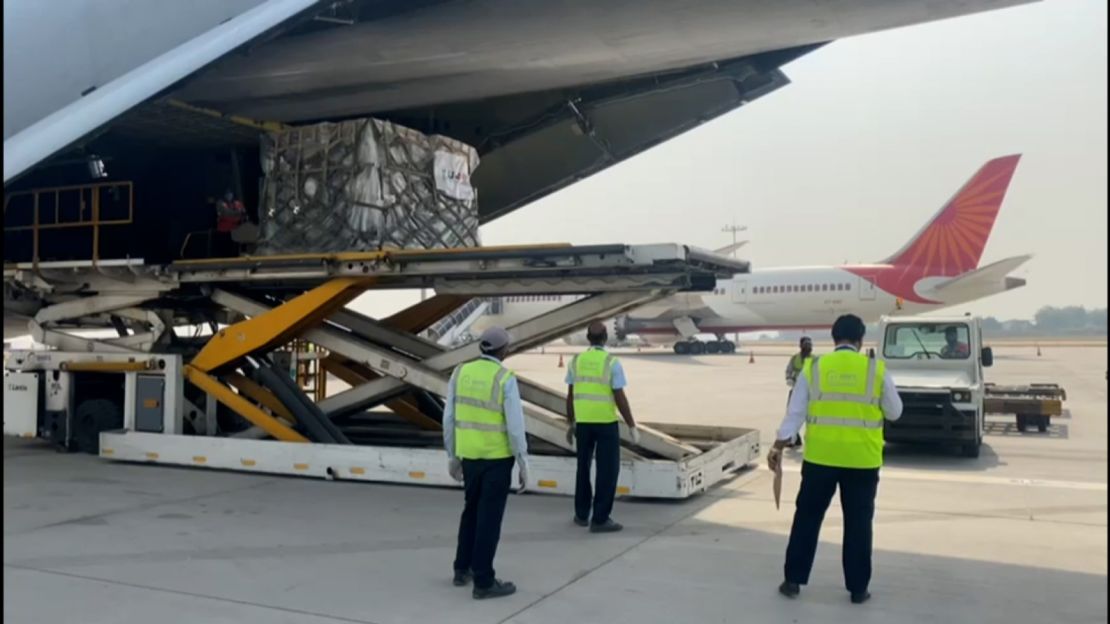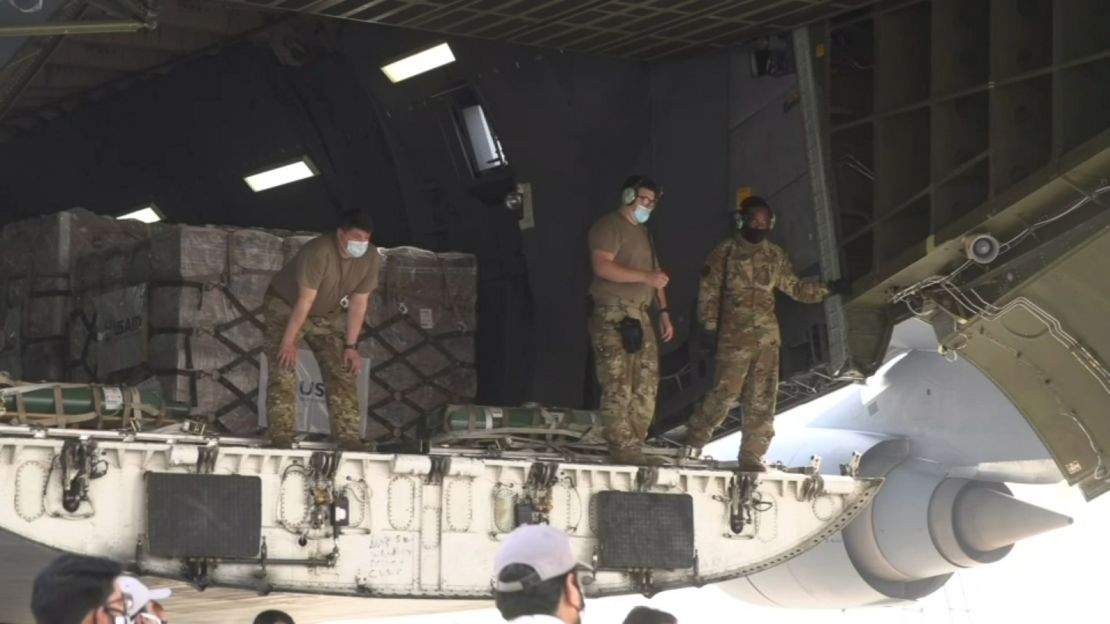As India’s Covid-19 crisis tipped past breaking point last month, dozens of countries pledged critical aid.
Planeloads of ventilators, oxygen supplies and antiviral drugs began arriving last week, with photos showing massive parcels being unloaded at New Delhi airport.
There’s just one problem:for many days, much of the cargo sat in airport hangars as hospitals on the ground pleaded for more provisions.
Medical workers and local officials are still reporting the same devastating shortages that have strained the health care system for weeks now – raising questions, even among foreign donors, of where the aid is going.
In a US State Department news briefing on Friday, a reporter asked where the US aid was, demanding “accountability for US taxpayers’ money,” according to the briefing transcript. “Is there anything being done to check on how it is being distributed, the aid that we are sending?” the reporter asked.

The Indian government issued a strong denial of any delay on Tuesday evening, saying it had installed a “streamlined mechanism” for allocating aid. Nearly 4 million donated items, spanning 24 categories, have already been distributed to 38 health care facilities across the country, the Health Ministry said in a statement.
But on the ground, many state and local authorities claim there has been little to no communication from the central government on how or when they would receive relief.
“We sent delegations to (the government) for clarity on supplies of (oxygen), drugs and vaccination drive but were not spoken to in clarity from the Union Government,” said Raghu Sharma, health minister of Rajasthan state, on Tuesday. “Regarding the import or foreign aid, no information or supply details have been shared with the state government.”
The central government has “kept states in the dark during the pandemic,” he added, calling for a more “transparent environment.”
The Health Ministry said on Tuesday that it had distributed aid to two hospitals in Rajasthan, in the cities of Jodhpur and Jaipur.
There are a number of feasible reasons for the delay: unnecessary bureaucracy, human error, or time-consuming protocol. But to those on the ground, such possible explanations matter little; all they want is for the government to take quicker action and get the aid to their ICU wards, where thousands are dying every day.
India's Covid-19 crisis, in pictures
India reported 382,315 new coronavirus cases on Wednesday and 3,780 virus-related deaths, according to the Health Ministry. The country has now recorded more than 20.6 million cases since the pandemic began.
Oxygen shortages are particularly pronounced in the union territory of Delhi, which does not produce its own oxygen and relies on the central government to send allocations from different manufacturers and states.
“It’s the duty of the government to provide us oxygen,” said Dr. S.C.L. Gupta, director of Batra Hospital in the capital New Delhi.
At least 12 patients, including a doctor, died at Batra Hospital on Saturday after it ran out of oxygen. Gupta said hospital staff spent the day telling authorities they only had a few hours of oxygen left; toward the end, they had to rely on oxygen provided by patients’ families.
“Patients are dying in front of us,” Gupta said. “I’m sorry we cannot save you.”
A logistical nightmare
One distribution problem highlighted by Indian media is simply that the government did not have protocols in place before receiving the aid, and had to quickly cobble together guidelines on allocation and coordination.
It took the government seven days to create a mechanism to distribute supplies to states, the Health Ministry said in a news release on Tuesday. They began working on the plan on April 26, and only issued their Standard Operating Procedure (SOP) – guidelines on how to distribute aid – on May 2. The release did not state what day the distribution of aid began.
In those seven days, more than 23,000 Indians died of Covid-19.

Even with the SOP issued, the process of distribution is complex, with room for further delay.
Once the aid arrives in India, it is received by the Indian Red Cross Society, which works closely with the government. The Red Cross works with customs to approve the goods, the Health Ministry said, adding that customs is “working 24 x 7 to fast track and clear the goods on arrival.”
After being cleared, the items are handed to the ministry and a government-owned health care product manufacturer called HLL Lifecare, which handles transportation of aid to its final destination.
But it’s a massive logistical undertaking because “the materials from abroad are currently coming in different numbers, specifications and at different times,” the ministry said in its Tuesday release. A number of problems might arise, it said: “in many cases,” the type or number of aid supplies don’t match the inventory list provided by the foreign donor.
Authorities then have to waste precious time “reconciling (discrepancies) at the airport” while the aid sits idle, according to the release. Only when the paperwork is updated with the correct details can authorities move forward with distribution.

India is a huge country, home to 1.3 billion people, and most of the foreign aid is being flown to New Delhi – meaning much of it then has to be redistributed to far-flung states. The military has been deployed to help with this process, with the air force flying supplies to various cities and making overseas flights, too.
States with high caseloads, or those that are regional medical hubs, will be prioritized, the Health Ministry said on Tuesday. Donations are also allocated to states with fewer resources or those in remote areas.
It’s unclear how much aid is still being processed, but images began emerging this week of supplies finally arriving on the ground.
The air force airlifted the “first batch” of 450 oxygen cylinders from the United Kingdom to Chennai on Tuesday, according to the city’s customs authority. Meanwhile, 350 oxygen concentrators from Hong Kong are being sent to Mumbai on Wednesday.
These supplies will only provide a modicum of relief, however. As of Tuesday, Chennai had more than 32,000 active cases, while Mumbai had over 56,000. Hospitals in both cities are so under-resourced and the situation so dire that patients are dying by the dozen.
Desperate patients wait for oxygen
As the government scrambles to get backlogged aid to desperate states, it is also working to increase domestic oxygen production. And at every turn, federal authorities have claimed they have enough supplies to meet states’ demands.
“The (daily) production of oxygen in the country was 5,700 metric tons (6,283 tons) on August 1, 2020, which has now increased to around 9,000 metric tons (9,920 tons),” a Health Ministry spokesperson said at a news conference on Monday. Last month, the ministry said it had 50,000 metric tons (55,115 tons) in surplus oxygen stocks.
On Monday, the ministry spokesperson again asserted, “There is enough oxygen available in the country.”

But doctors, officials and desperate patients tell a very different story.
In a hospital in Meerut, a city in Uttar Pradesh, one family has worked around the clock to care for their 55-year-old mother in the intensive care unit. The family told CNN this week she had been in the hospital for six days before getting a ventilator, and they had to bring their own oxygen cylinder.
At one point, her vitals began dropping dangerously; her sons pumped her chest frantically, crying out and clutching her hands as family members wailed next to the bed. A doctor was able to help stabilize the woman – but later, she flatlined again. This time, she could not be revived; her body was left in the ICU for nearly an hour before it was moved.
The same scenes are playing out in nearly every major city. In New Delhi, the situation has deteriorated so badly that India’s Supreme Court ordered the central government to address the oxygen shortages there by the end of Monday.
Similar hearings have taken place in the Delhi High Court. “Do you mean we will shut our eyes to the people dying in Delhi?” the court told the central government on Saturday, according to CNN affiliate CNN-News18. “Enough is enough.”
Some state authorities, too, have come under fire for their handling of the oxygen crisis. A high court in Uttar Pradesh demanded “immediate remedial measures,” pointing to specific instances of patients dying due to oxygen shortages.
“Death of Covid patients just for non supplying of oxygen to the hospitals is a criminal act and not less than a genocide by those who have been entrusted the task to ensure continuous procurement and supply chain of the liquid medical oxygen,” the court said on Tuesday.
The central government has responded by ramping up emergency measures.
Two of five on-site oxygen plants earmarked for Delhi hospitals would be operational on Wednesday, the Health Ministry said on Twitter. The government plans to set up 500 plants across the country within three months, according to a ministry statement.
This week, some of these increased oxygen supplies are being sent to various hard-hit states by rail, in what has been dubbed the “oxygen express.”
But until these supplies arrive, either from domestic plants or foreign donors, patients have no choice but to wait, terrified for their lives.




























































